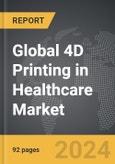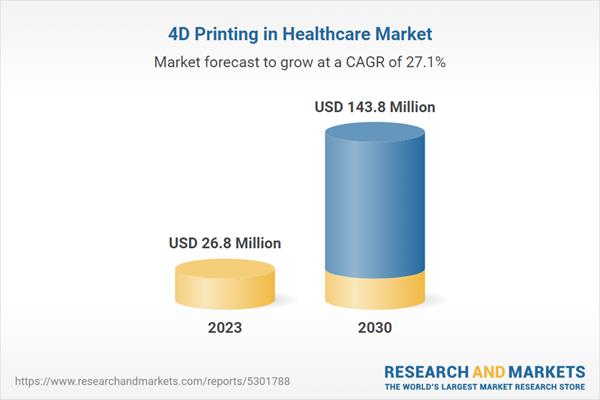Global 4D Printing in Healthcare Market - Key Trends and Drivers Summarized
How Is 4D Printing Revolutionizing Healthcare?
4D printing is set to revolutionize healthcare by introducing dynamic, adaptable, and personalized solutions that go beyond the capabilities of traditional manufacturing techniques. Unlike 3D printing, which creates static objects, 4D printing utilizes smart materials that can change their shape or properties over time in response to specific environmental stimuli such as temperature, moisture, pH levels, or biochemical signals. This makes it ideal for healthcare applications, where adaptability, precision, and customization are critical.For example, 4D printing can be used to create medical devices that adjust to the body's conditions, such as implants that change shape to better fit the patient or drug delivery systems that release medication in response to biological cues. This technology also opens up new possibilities for creating more sophisticated prosthetics, stents, and tissue scaffolds, which could respond to changes in the body and improve patient outcomes over time. The ability to design devices that evolve or adapt after implantation is a game-changer in personalized medicine, offering more effective treatments that cater specifically to individual patient needs.
Why Is 4D Printing A Game-Changer In Personalized Medicine And Medical Devices?
4D printing is gaining significant traction in personalized medicine and medical devices because of its ability to create dynamic and patient-specific solutions that adapt over time. In personalized medicine, the focus is on creating treatments and devices that are tailored to each individual's unique anatomy and biological conditions. 4D printing allows for the creation of medical implants, prosthetics, and other devices that can morph or reshape in response to a patient's body, offering a more customized fit and better functionality. For instance, stents made with 4D printing technology could expand or contract based on the patient's blood flow, providing a more effective treatment for cardiovascular diseases.This technology also enables the development of drug delivery systems that can respond to specific stimuli within the body, such as pH or temperature changes, to release medication at optimal times, improving the precision and effectiveness of treatments. Beyond personalized implants, 4D printing is also transforming the design of external prosthetics and orthopedic devices.
These devices can be programmed to adapt to a patient's movements or the changing environment, improving comfort and mobility. For example, 4D-printed braces or splints could adjust their rigidity or shape as the patient heals, offering support when needed and flexibility as the recovery progresses. This dynamic nature allows for more versatile medical devices that reduce the need for frequent adjustments or replacements, improving patient outcomes and comfort.
What Are the Main Challenges Preventing the Wide Adoption of 4D Printing In Healthcare?
Despite its promise, 4D printing faces several key challenges that are slowing its wider adoption in healthcare. One of the primary obstacles is the complexity and cost of the smart materials required for 4D printing. The development of shape-memory polymers, hydrogels, and other stimuli-responsive materials is still in its early stages, and these materials tend to be expensive compared to traditional medical-grade materials. Ensuring that these smart materials can consistently respond to the body's conditions, such as temperature changes or biochemical signals, requires advanced research and precision manufacturing, which increases production costs. Additionally, regulatory challenges loom large in the healthcare sector.Medical devices and implants must undergo rigorous testing and certification to ensure their safety, reliability, and long-term durability. Another significant challenge is the lack of established standards for 4D printing in medical applications. The technology is still relatively new, and there is a shortage of regulatory frameworks and clinical guidelines for how these adaptive devices should be designed, tested, and used in patient care.
This uncertainty can make it difficult for healthcare providers and manufacturers to adopt 4D printing at scale, especially in industries like medical devices where safety is paramount. The performance of 4D-printed implants or drug delivery systems could vary depending on the patient's unique biological conditions, making it crucial to develop systems that can adapt accurately and consistently.
What Is Driving the Rapid Growth of 4D Printing In Healthcare?
The growth in 4D printing in healthcare is driven by several key factors. One of the most significant drivers is the increasing demand for personalized and adaptive medical solutions. As healthcare shifts toward more individualized treatments, 4D printing offers the ability to create patient-specific implants, prosthetics, and devices that can dynamically adjust over time to better suit the patient's needs. This adaptability is especially valuable in areas such as orthopedics, cardiovascular care, and regenerative medicine, where treatments need to evolve with the patient's changing health status. Technological advancements in material science are also accelerating the adoption of 4D printing in healthcare.New smart materials that can respond to environmental stimuli, such as temperature, moisture, and pH, are being developed specifically for medical applications. These materials expand the possibilities for creating implants and devices that adapt to the body's internal conditions, improving both effectiveness and comfort. Additionally, advances in biocompatibility and biodegradability of 4D-printed materials ensure that these adaptive devices are safe for long-term use within the human body, further driving their appeal in medical applications.
The push for minimally invasive treatments is another key factor fueling the growth of 4D printing in healthcare. Moreover, the potential for 4D-printed drug delivery systems to release medication in response to biological triggers offers more precise, controlled treatment options, which is particularly valuable in treating chronic conditions such as cancer, diabetes, or autoimmune disorders. As these innovations continue to develop, the market for 4D printing in healthcare is expected to grow rapidly, driven by the need for more effective, customizable, and dynamic medical solutions that improve patient outcomes and reduce the overall burden on healthcare systems.
Key Insights:
- Market Growth: Understand the significant growth trajectory of the Software & ServicesComponent segment, which is expected to reach US$81.9 Million by 2030 with a CAGR of a 29.0%. The Equipment Component segment is also set to grow at 25.5% CAGR over the analysis period.
- Regional Analysis: Gain insights into the U.S. market, estimated at $7.8 Million in 2023, and China, forecasted to grow at an impressive 26.0% CAGR to reach $21.3 Million by 2030. Discover growth trends in other key regions, including Japan, Canada, Germany, and the Asia-Pacific.
Why You Should Buy This Report:
- Detailed Market Analysis: Access a thorough analysis of the Global 4D Printing in Healthcare Market, covering all major geographic regions and market segments.
- Competitive Insights: Get an overview of the competitive landscape, including the market presence of major players across different geographies.
- Future Trends and Drivers: Understand the key trends and drivers shaping the future of the Global 4D Printing in Healthcare Market.
- Actionable Insights: Benefit from actionable insights that can help you identify new revenue opportunities and make strategic business decisions.
Key Questions Answered:
- How is the Global 4D Printing in Healthcare Market expected to evolve by 2030?
- What are the main drivers and restraints affecting the market?
- Which market segments will grow the most over the forecast period?
- How will market shares for different regions and segments change by 2030?
- Who are the leading players in the market, and what are their prospects?
Report Features:
- Comprehensive Market Data: Independent analysis of annual sales and market forecasts in US$ Million from 2023 to 2030.
- In-Depth Regional Analysis: Detailed insights into key markets, including the U.S., China, Japan, Canada, Europe, Asia-Pacific, Latin America, Middle East, and Africa.
- Company Profiles: Coverage of major players in the Global 4D Printing in Healthcare Market such as 3D Systems, Cadence Design Systems, Dassault Systèmes, Electro Optical System, EnvisionTEC and more.
- Complimentary Updates: Receive free report updates for one year to keep you informed of the latest market developments.
Some of the 36 companies featured in this Global 4D Printing in Healthcare market report include:
- 3D Systems
- Cadence Design Systems
- Dassault Systèmes
- Electro Optical System
- EnvisionTEC
- EOS GmbH Electro Optical Systems
- Materialise
- Materialise NV
- Organovo Holdings Inc.
- Poietis
- Stratasys Ltd.
Table of Contents
Companies Mentioned (Partial List)
A selection of companies mentioned in this report includes, but is not limited to:
- 3D Systems
- Cadence Design Systems
- Dassault Systèmes
- Electro Optical System
- EnvisionTEC
- EOS GmbH Electro Optical Systems
- Materialise
- Materialise NV
- Organovo Holdings Inc.
- Poietis
- Stratasys Ltd.
Table Information
| Report Attribute | Details |
|---|---|
| No. of Pages | 92 |
| Published | December 2025 |
| Forecast Period | 2023 - 2030 |
| Estimated Market Value ( USD | $ 26.8 Million |
| Forecasted Market Value ( USD | $ 143.8 Million |
| Compound Annual Growth Rate | 27.1% |
| Regions Covered | Global |









